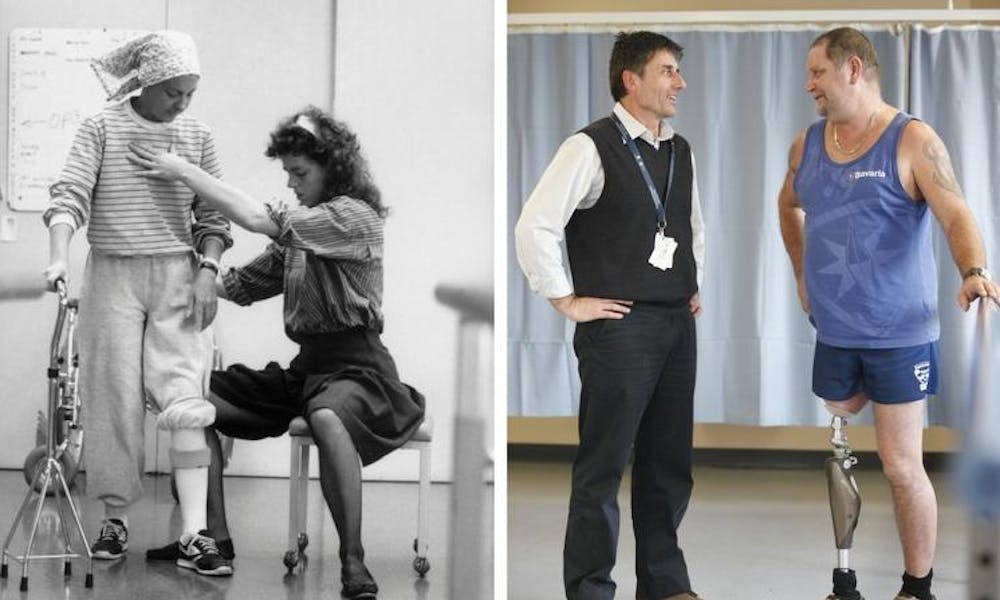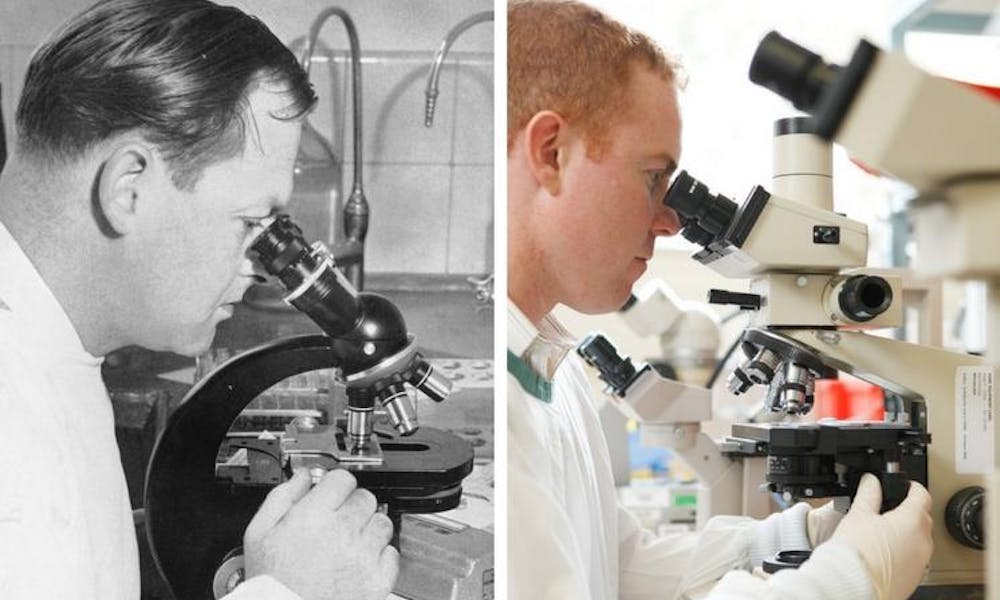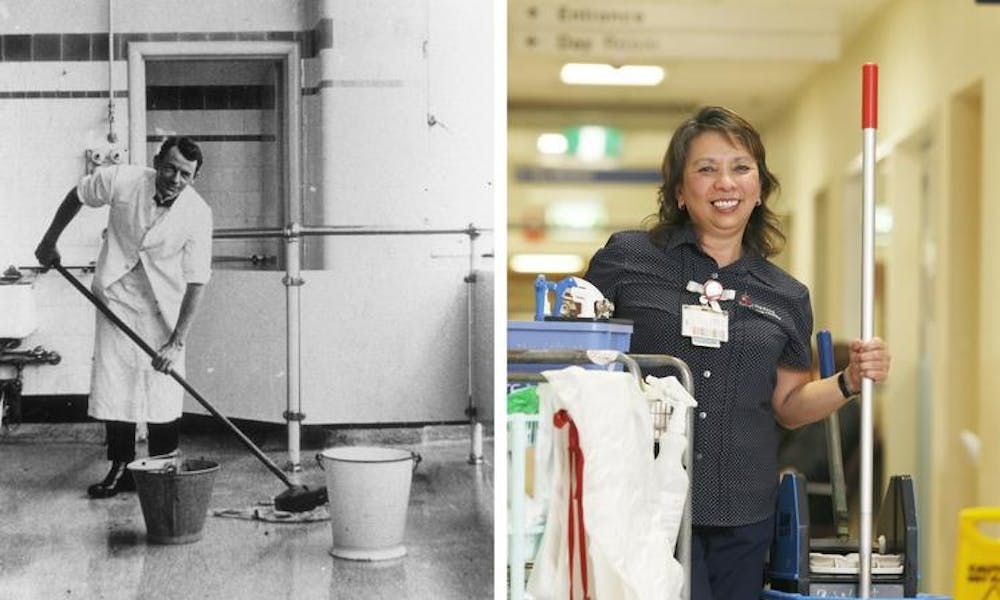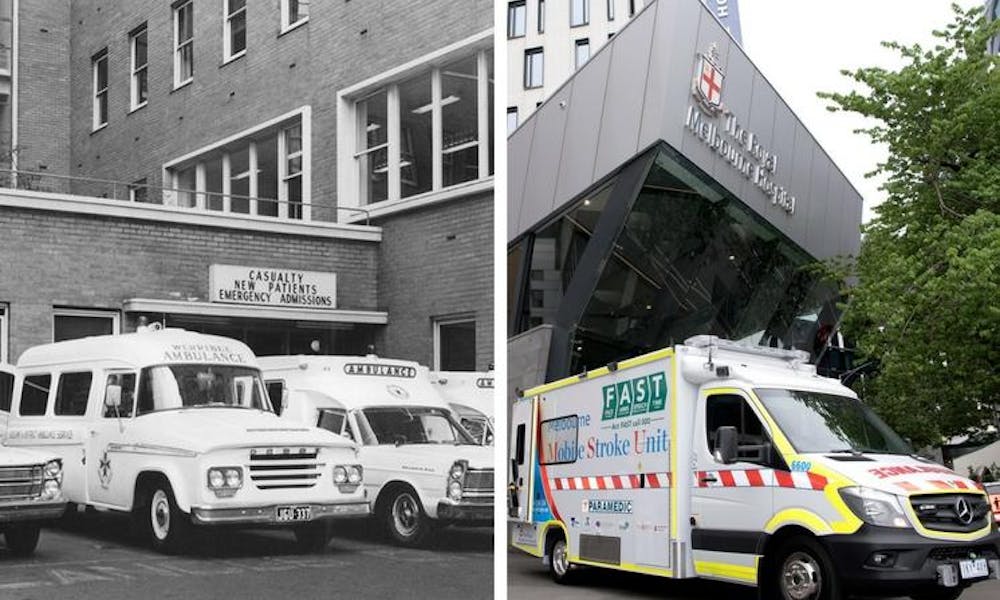Be transported back in time and see some of our most-treasured historical photos placed side-by-side with modern-day versions, and read about how we've transformed over the years.
Then and Now was compiled for our 170th anniversary in 2018.
Flags with these photographs were also hung in the Haymarket Roundabout near the RMH Parkville.

Nursing
Then: 1890s
Before 1890 nurses were not required to have any formal qualifications to work at the RMH. That all changed when Lady Superintendent Isabella Rathie introduced the first formal teaching program for nurses in 1890.
The course was only two years long and covered basic nursing practices as well as studies in anatomy, surgery and physiology and medicine.
Now: 2018
Fast-forward to 2018, and our nurses complete a three-year undergraduate degree plus a graduate nursing program, with the option of postgraduate study in a specialty area afterwards.
In 2018 we welcomed 120 graduate nurses to the RMH as part of our Graduate Nurse Program. Each one of them completed two six-month clinical rotations across a range of specialties.
The growth and development of nursing over centuries has led to major positive change in the workforce, with many of our nurses leading the way in medical research, nursing education and patient quality and safety.
Learn more about today's nursing careers at the RMH.

Theatre and surgery
Then: 1913
The RMH, which was situated on Lonsdale Street in 1913, had just four operating theatres.
The position of Theatre Sister was created in 1912, and thereafter all third-year student nurses spent a semester in operating theatres. June Allen, the sister in charge of operating theatres from 1956-72, set up a 12-month postgraduate course in operating theatre nursing, the first of its kind in Victoria.
Now: 2018
A new hospital and 105 years later, the RMH had grown to 14 operating theatres by 2018.
By 2018 our Perioperative Services included various sub-departments such as Theatres, Post Anaesthetic Care Unit, Anaesthesia and Pain Management, Day of Surgery Admission, the Central Sterile Supply Department (CSSD) and the Day Procedure Unit.
In 2018 around 100 sterilisation cycles were performed each day to keep 20,000 surgical instruments clean. More than 23,900 elective theatre procedures were performed in 2016-17.
In February 2016 our TUG mobile robots Susan, Peter and Dot joined the team to transport surgical instruments to and from the RMH and Peter MacCallum Cancer Centre theatres to CSSD to be cleaned. They could 'talk', call a lift and navigate their way through the hospital using a pre-programmed GPS. Together they travelled 19km and made 290 deliveries per day.
Learn more about general surgery at the RMH.

Allied health
Then: 1890s
From 1898 the first allied health professionals employed by the hospital were masseurs, now known as physiotherapists. In 1905, the medical superintendent recommended that a school of massage be established within the hospital.
That was how the Australian Massage Association was formed. Students paid a fee of one guinea to study.
Women were at the forefront of establishing the various other allied health departments within the RMH, including the first social worker and dietitian in 1929.
Now: 2018
By 2018 our allied health service included more than 400 staff across the following areas of allied health:
- Aboriginal Hospital Liaison
- Exercise Physiology
- Facial Prosthetics
- Music Therapy
- Nutrition
- Occupational Therapy
- Pastoral Care
- Physiotherapy
- Podiatry
- Prosthetics and Orthotics
- Psychology
- Social Work
- Speech Pathology and Audiology
- Transcultural and Interpreting Services
Learn more about today's allied health careers at the RMH.

Facial Prosthetics
Then: 1940s
Facial Prosthetics is a combination of science and art and the Facial Prosthetics team at the RMH have long been pioneers in their field.
In the early days, prosthetics were made from hard acrylics and sterling silver. Much of the early work was designed for soldiers returning from war with horrific facial injuries.
Now: 2018
By 2018 the role had expanded to include not only eyes, ears, and noses but also fingers, toes, breasts and other prostheses.
The Facial Prosthetics service designed, made, fit and maintained camouflage facial prosthetics for patients who'd had cancer surgery, congenital deformities, accidents and trauma.
Materials like titanium and silicon were commonly used and even more recently, new technology such as 3D-printing further advanced the field, enabling the team to produce more realistic facial prosthetics faster, saving hours of modelling and reducing the patient’s time spent at hospital.
As of 2018 the RMH Facial Prosthetics department manufactured approximately 35 new eyes, 40 ears, 25 noses and 20 other miscellaneous prosthetics per year.
Learn more about what the Maxillofacial Prosthetics Department looks like at the RMH today.

Research
Then: 20th and early 21st century
The RMH has been at the forefront of many world-renowned innovations that have helped shape health care today,
These include:
- The first successful kidney transplant in Australia in 1963
- The development of Australia’s first cardiac pacemaker in the mid-1960s
- The invention of artificial blood vessels, the first defibrillator operation in the Southern Hemisphere and the pivotal groundwork for the National Bowel Cancer Screening Program, all in the 1980s
- Australia’s first keyhole coronary bypass operation in the 1990s
- Australia’s first ABO blood incompatible kidney transplant
- One of the first hospitals in the world to introduce wireless ‘Pill Cam' endoscopy in 2001
In the 2010s we announced a world-first investigation into the use of Botox to reduce the debilitating tremors and shakes in people with multiple sclerosis, and conducted a world-first clinical trial of a new drug that kills cancer cells in people with advanced forms of chronic lymphocytic leukaemia.
Now: 2018
The RMH is based in the heart of the Melbourne Biomedical Precinct. By 2018 the Precinct had established itself as a major global research and teaching powerhouse with its 30 health services and research and academic partners sharing a formidable history of ground-breaking medical discoveries and developments.
Together, the Precinct partners employed around 10,000 researchers as of 2018.
In 2017 we opened a $1 million Clinical Trials Centre, a purpose-built state of the art facility where clinicians and patients from all specialities could come together to provide and receive care in a dedicated centre. We also published over 800 journal articles.
There were over 800 active research projects as of 2018, of which more than 300 were clinical trials.
Learn more about the research happening today at the RMH.

Learning
Then: 1860s and 1980s
The University of Melbourne’s Medical School was established in 1862. Two years later, three people became the first medical students to be admitted to the Melbourne Hospital for clinical instruction.
While students' access to the wards was not refused, the hospital made little effort to encourage their practical instruction. The University of Melbourne Council appointed clinical lecturers from the hospital’s medical staff in 1884 in an effort to improve clinical teaching for medical students.
Meanwhile, the move from hospital-based nursing to university-based nursing education began in the 1980s. The last graduation of student nurses from the RMH’s School of Nursing occurred in September 1993, bringing to a close 103 years of the RMH basic nurse education.
Now: 2018
The RMH welcomed 80 medical interns to the hospital in 2018. They undertook 10-week rotations in General Medicine and Surgery and an eight-week rotation though the Emergency Department, among other specialties, as part of their intern year.
By 2018 both our doctors and nurses had access to the RMH's state-of-the-art Clinical Simulation Centre, an education and training facility where staff undertake simulation-based courses and programs, targeted towards improving patient care and reducing clinical risk.
Learn more about today's medical internships at the RMH.

Our support staff
Then: 1840s
A huge part of keeping the RMH functioning and safe for our patients is keeping it clean. Since 1848 the number of cleaners and the technology our cleaners use has changed dramatically.
Even in 1952 there were just 11 cleaners rostered on during the day and seven cleaners overnight.
Now: 2018
By 2018 the RMH employed roughly 170 cleaning staff, who were required to undertake a Certificate 3 in Health Patient Services.
And by 2018 it was not just cleaners - there was a range of other support roles essential to patient care at the RMH. Our 170-plus Clinical Assistants provided clinical support on the wards by transporting patients, assisting clinical staff, cleaning and providing general ward support.
In 2018 there were 80 people on our Food Services team. In one year, they served more than 630,000 meals at the RMH Parkville and our kitchen produced more than two million serves of vegetables and more than 35 tonnes of mashed potato.
Learn more about today's meals for patients at the RMH.

Our home
Then: Early 1900s
The Melbourne Hospital buildings and facilities, which were at that time located on Lonsdale Street, were condemned by a Royal Commission in 1892 because they were in such a state of disrepair.
The decision was reached in 1908 to build a new hospital on the corner of Lonsdale and Swanston Streets. The foundation stone was laid in 1912, and the new hospital opened on 22 July 1913.
Unfortunately the new site still wasn’t big enough for the growing number of patients. The decision was made in 1929 to reserve an area of land that was being used as a horse, cow and pig market in Parkville and build what we now know as the RMH Parkville.
With the outbreak of the Second World War, the new hospital was occupied by US soldiers for two years from March 1942. After the US Army departed, the hospital moved in with the help of 16 ambulances, transferring 200 patients between old and new hospitals.
Now: 2018
By 2018 the RMH Parkville had 470 beds and had undergone significant construction over the years.
That included the expansion of the B-Building as part of the Victorian Comprehensive Cancer Centre (VCCC) project. It included a new 42-bed capacity Intensive Care Unit, a 32-bed Haematology and Bone Marrow Transplant Ward and a Central Sterile Supply Department.
Learn more about the locations of the RMH today, including and the RMH Parkville and the RMH Royal Park.

Emergency and Trauma care
Then: 1848
The first ever casualty patient of the Melbourne Hospital came through the door on 18 March 1848. His name was John Docker, a seaman from the ship Stag, who suffered a broken thigh.
The department was renamed from Casualty to Emergency in 1974 and the interior of the building was dramatically modernised.
Now: 2018
By 2018 the RMH provided emergency, trauma and critical care 24 hours a day, seven days a week and was one of two major adult trauma services in the state.
We achieved formal Level-1 Trauma Verification from the Royal Australasian College of Surgeons in 2012, making us the first Major Trauma Centre in the Victorian State Trauma System to achieve this status.
By 2018 we were treating 4000 trauma patients every year, with up to 1000 of those being classified as major traumas. Our helipad opened in 2004 and roughly 40 helicopters were landing each month. In 2016-17, our Emergency Department provided urgent care to more than 74,000 people, an average of 200 patients a day.
In 2017 we were proud to launch the Mobile Stroke Unit (MSU), the first of its kind in Australia. The MSU is a fully-equipped, custom-built ambulance with an on-board CT scanner capable of imaging the patient’s brain to detect the type of stroke they are experiencing to immediately start assessment and treatment.
Learn more about what the Emergency Department and Major Trauma Service looks like at the RMH today.

